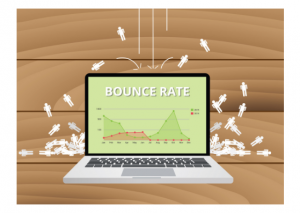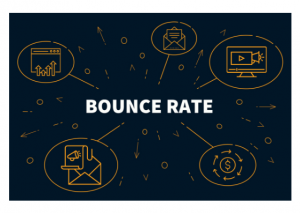 8 Ways to Reduce Your Bounce Rate
8 Ways to Reduce Your Bounce Rate
In today’s article, we’ll be offering our best advice on how you can reduce the bounce rate on your website.
Businesses can’t just accept that their website has a high bounce rate. It can be hard to digest, because as the owner you love your own website, but why don’t your target audience?
Bounce rates are often over looked – but they can actually tell businesses a lot about how their site is perceived by visitors.
What’s a Bounce Rate?
A bounce rate is a single page session on your website – it’s the percentage of users who have visited your page without any further interaction.
Google offer a good definition, “In Analytics, a bounce is calculated specifically as a session that triggers only a single request to the Analytics server, such as when a user opens a single page on your site and then exits without triggering any other requests to the Analytics server during that session.”
What’s a Good Bounce Rate?
This is a really tricky question with no concrete answer.
Typically, the higher your bounce rate the worse it is.
Although, if the success of your site doesn’t depend on users visiting more than on page then a high bounce rate isn’t much to worry about.
If your website only has a single page or single-page sessions are expected (maybe like a blog) then a high bounce rate is completely fine.
High bounce rates are concerning when they impact the success of the website. For example, perhaps you’re looking for consumers to convert by visiting another web page. In this case, the lower the bounce rate the greater chances of conversions.
To one website an 80% bounce rate might be fine – but to another it’s disastrous.
But ultimately, businesses should be working to reduce bounce rates, increase conversions and boost user experience.
What a High Bounce Rate Suggests
In a lot of cases, a high bounce rate indicates that the landing page isn’t doing its job properly. It isn’t engaging consumers enough for them to want to take a look around your website, convert or make a purchase.
High bounce rates often signal that something is wrong and needs to be fixed – maybe it’s the design, content or organisation.
How to Reduce Bounce Rates
1. Improve Your Content
If your content isn’t clear, easy to ready or organised then viewers will likely be put off. Big pieces of text tend to scare readers, so try sticking to shorter, simple paragraphs.
To make your content more readable and user friendly, consider
- – Bullet points to break up text
- – Heading / sub headings
- – The use of images
- – Bold / italic words when appropriate
- -Ask thought provoking questions
- – Colour
Whilst we’d all love our readers to hang on to every last sentence we type, it just doesn’t happen. Don’t over-load them with information that they’re not likely to read.
2. Don’t Let Pop-ups Get in the Way
Are you a fan of pop-ups? There’s a lot of dividing opinions, but we think they’re a good marketing tool if used correctly.
If you are going to implement pop-ups to your website, place them strategically and ensure they don’t obstruct visitors.
We’ve discussed whether websites should feature pop-ups before, catch up – Should Websites Feature Pop-ups?
3. Clear CTAs
if you want your visitors to fulfil an action – simply tell them. Encourage them to visit another page, whether it be to buy a product, read similar content, enquire about a service or contact you, consumers need to be told exactly what you want them to do.
4. Focus on Your Target Audience
You might have a targeting problem.
It’s possible your bounce rate is so high because the wrong people are visiting your website. Think about the keywords you use, are they going to attract the right people? Will the traffic be targeted and relevant to your business?
Choosing the right keywords is paramount – How to Choose the Right Keywords for Website Optimisation
5. Your SEO Isn’t Good Enough
Maybe your keywords aren’t in the right place, so your target audience can’t easily find you. Website optimisation is crucial for the right consumers to find your website. If you haven’t included targeted and specific keywords for your website, then unfortunately your target market will struggle to find you.
Remind yourself where keywords should go on your website pages – Where to Place Keywords For Website Optimisation
6. Your Page is Too Slow
If your page is taking what feels like a decade to load, then why would consumers click to visit a second page?
If you think you have issues with page loading times, then check out our previous article – 4 Tips to Speed up Your Website
7. Your Design Is Unresponsive
There’s a vast variety of screen devices that consumers could use to access your site. Desktops, tablets and mobile phones all have varying screen sizes – so your website’s design needs to respond accordingly based on the individual device.
Check out our quick tips – 7 Quick Tips for a Responsive Website
Conclusion
So, we’ve shown you 7 ways you can reduce your bounce rate and encourage visitors to your site to stay for longer.
Your bounce rate won’t dramatically decrease over night – but over time the amount of time that users spend reading your content will increase.
Final words of advice: stick at it and continue trying to improve.
Why not check out our Digital Marketing Terms Glossary?
About the author:
Marie Harwood is a Digital Marketing Assistant at Different Gravy Digital, Hale, Cheshire.
Different Gravy Digital are a full service Digital Marketing Agency operating in the Hospitality & Leisure, Financial Services, Legal & Property sectors. Products and services range from; 3D & 360° Tours, Website Design & Build, Social Media, Video Production, Search Engine Optimisation (SEO), Content Creation, Email Marketing, Online Feedback / Review Systems and Paid Advertising (Google, Bing and Social Media).
Contact Details:
marie@differentgravydigital.co.uk
0161 706 000
120a Ashley Road, Hale, Altrincham, Cheshire, WA14 2UN